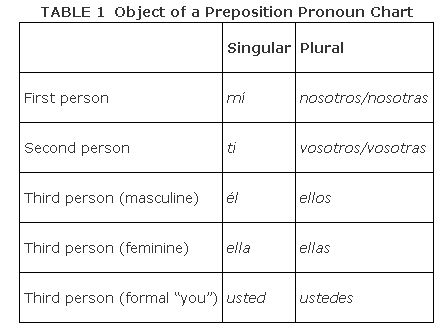Pronouns Used after a Preposition
A pronoun that follows a preposition is called the object of a preposition; in English, these pronouns are the same as any other object (indirect or direct) pronoun. In Spanish, however, there is a special case of pronouns that must be used whenever replacing a noun that follows a preposition. The pronouns in Table 1 are formally called pronombres tónicos, but it is easier to think of this case as the “prepositional pronouns.” Notice that the pronouns used after a preposition are exactly like subject pronouns, with the exceptions of mí and ti. Also notice that mí has an accent mark, but ti does not.

As you'll notice in the examples below, these pronouns may sound strange to the ears of an English speaker because the pronouns used after a preposition sound like direct and indirect object pronouns in English and like subject pronouns in Spanish (except for mí and ti).
- La clase de álgebra es mejor para ella.
- The algebra class is best for her.
- Quiero viajar con ellos porque ellos conocen bien la nación.
- I want to travel with them because they know the nation well.
- Elena nos invita a nosotros porque somos buenos amigos.
- She invites us because we are good friends.
When the preposition con is followed by the pronoun mí, the two words join to become a single word: conmigo. Note that the accent mark disappears from mí when ‐go is added. Conmigo is translated as “with me” and must be used whenever con is followed by mí. The same thing happens when con is followed by ti: Contigo means “with you” and must be used whenever the preposition con is followed by ti.
- Alejandro debe explorar conmigo porque yo conozco todas las cuevas de Guadix.
- Alejandro should explore with me because I know all the caves of Guadix.
- Memo no quiere bailar contigo. Él desea bailar conmigo.
- Memo doesn't want to dance with you. He wants to dance with me.
|
|
|
|
|
|
|
|
|
|
|
|
|
|
|
|
|
|
|
|
|
|